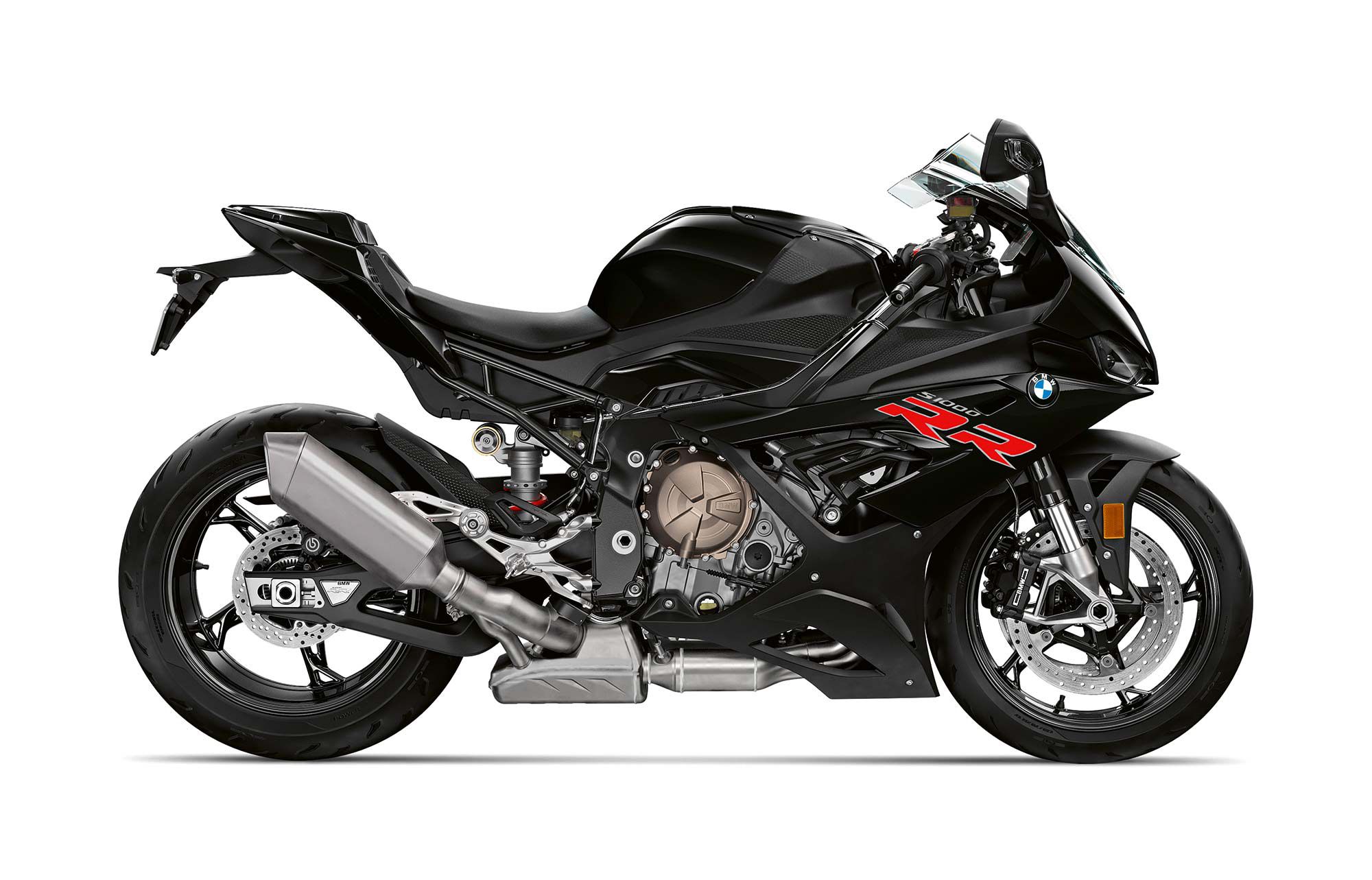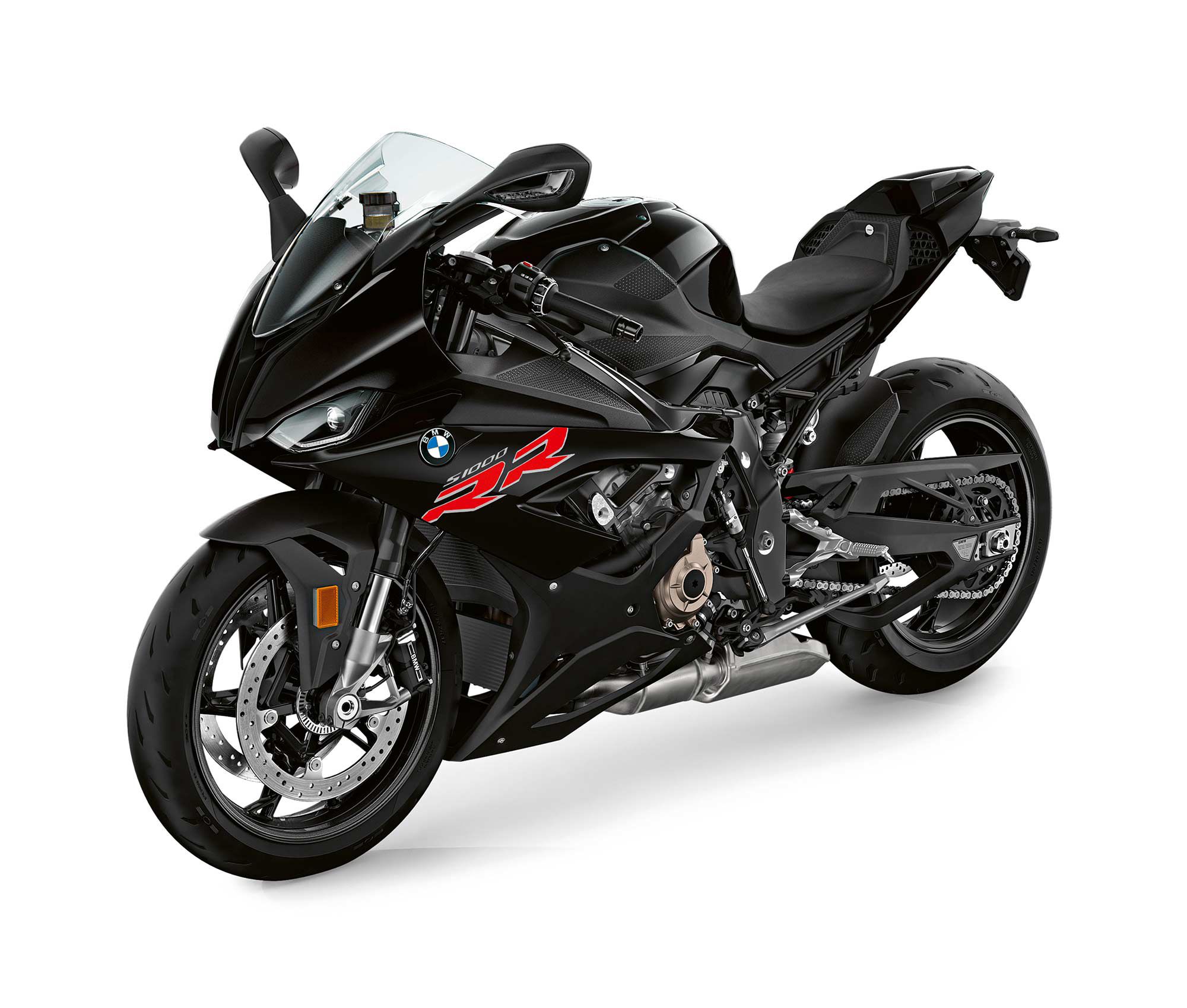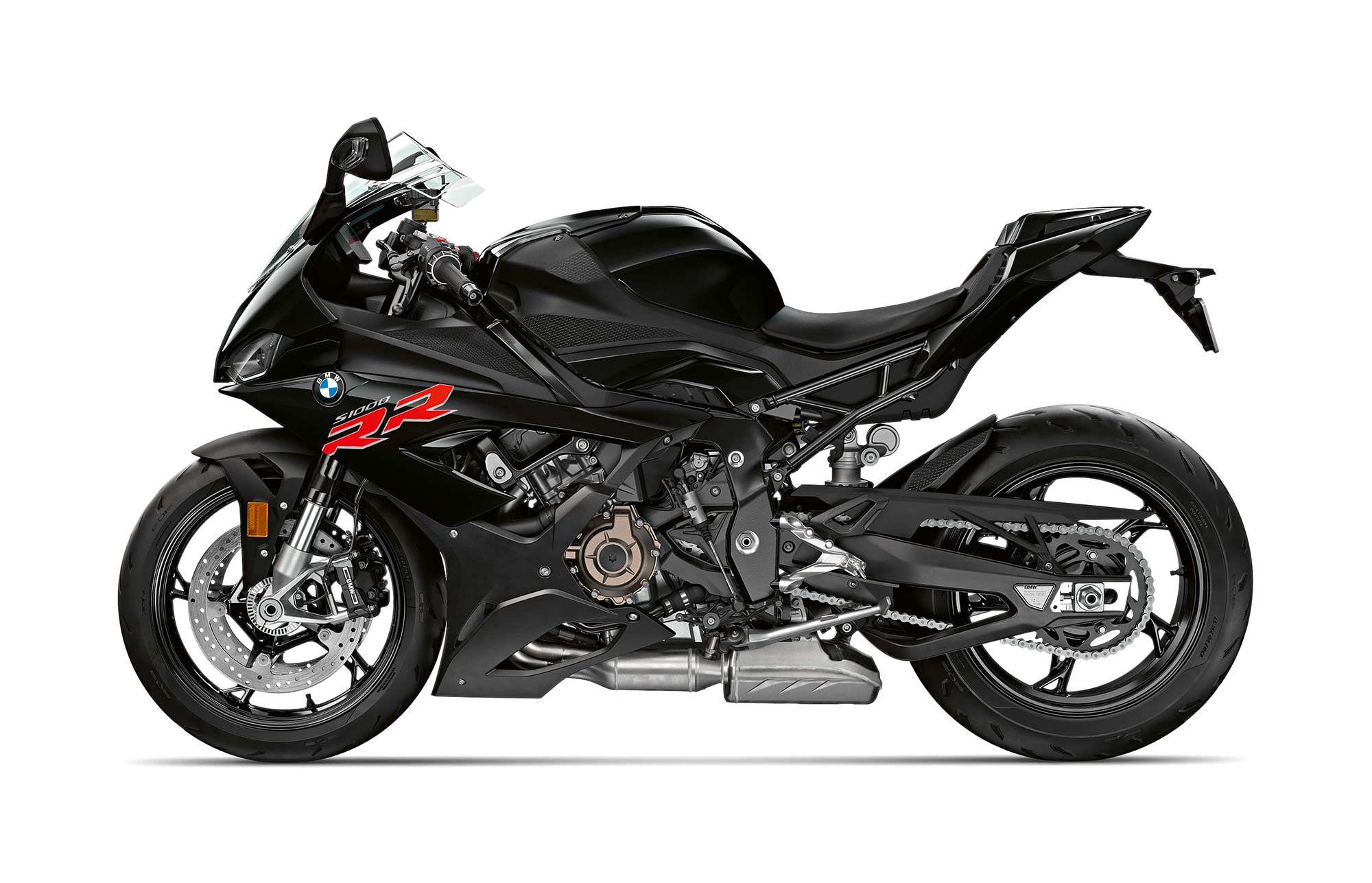
Ups
- More and improved power following 2020 updated
- Less weight in engine and chassis
- Most agile superbike in the class
Downs
- Major midrange power dead zone
- Traction control still too overbearing near limit
- Navigating settings is laborious and nonintuitive
Verdict
Not many manufacturers are putting much effort into their sportbikes these days, but BMW is one of those bucking the trend with its S 1000 RR flagship. Numerous updates over the years have kept the Beemer at or near the top of a very competitive sportbike heap, and for serious trackday or club racers, it’s a very solid choice.
Overview
The S 1000 RR was BMW’s first foray into the supersport sportbike category, and it bucked the company’s reputation for unorthodox designs with its conventional transverse inline-four engine nestled in a twin-spar aluminum frame, plus a conventional fork. The BMW also was equipped with a host of electronic rider aids that on paper were a step above the competition. Its resulting performance was certainly unconventional; the engine’s power was far superior to rival units, and other key factors resulted in the S 1000 RR garnering Best Superbike in Cycle World’s coveted Ten Best Bikes for 2010.
BMW has continually updated the S 1000 RR since then, with the latest upgrade for the 2020 model introducing a host of changes, including an entirely new engine with ShiftCam variable cam technology, revised chassis, and upgraded electronics.
Updates for 2021
There are no updates for 2021 to the S 1000 RR. Available colorways are Light White/Racing Blue Metallic/Racing Red (available with optional M Package only), Mineral Gray Metallic, and Black Storm Metallic.
Pricing and Variants
The base-model S 1000 RR retails for $16,995, but a number of packages and add-ons from BMW will drive the cost up significantly. The Mineral Gray Metallic colorway will set you back another $375 (the Black Storm Metallic motif is no charge).
The $4,250 M Package includes the BMW Racing-inspired Light White/Racing Blue Metallic/Racing Red livery, the Sport seat, electronics updates that include three individually configurable Race Pro Ride Mode settings, M carbon wheels with 5mm-thick brake discs, M lightweight battery, and GPS lap trigger.
The $2,095 Carbon Package includes a CFRP front and rear fender, chain guard, countershaft cover, and both upper fairing side panels.
The $2,825 Premium Package includes cruise control, an Akrapovič titanium slip-on muffler with carbon end cap, USB charging socket, Ride Modes Pro with Race Pro settings, Dynamic Damping Control (for suspension), M Endurance maintenance-free drive chain, heated grips, and tire pressure monitoring system.
Competition
Competitors for the BMW include the Aprilia RSV4 1100, Ducati Panigale V4/V4 S, Honda CBR1000RR-R Fireblade SP, Kawasaki Ninja ZX-10R, Suzuki GSX-R1000/R, and Yamaha YZF-R1/R1M.
Check out this comparison test between the Aprilia RSV4 1100, Ducati Panigale V4 S, and the BMW S 1000 RR.
Powertrain: Engine, Transmission, and Performance
The 999cc inline-four engine has seen numerous updates since its 2009 debut, with the latest 2020 updates the most extensive, resulting in a peak of 182.65 hp at 13,580 rpm and a torque reading of 77.06 pound-feet at 11,040 rpm on the CW dyno. Although top-end power is excellent, unfortunately BMW was forced to limit midrange power in order to pass US EPA sound regulations, resulting in a major midrange flat spot between 6,000–8,000 rpm. “It’s a frustrating dead zone that requires the BMW to be ridden a bit like a 600cc supersport, utilizing sweeping lines and precise shifts to keep the engine spinning above the power abyss,” Michael Gilbert stated in the CW comparison test with the Ducati Panigale V4 S and the Aprilia RSV4 1100. The Gear Shift Assist Pro now comes standard on the S 1000 RR, which allows clutchless downshifting as well as full throttle upshifts.

Handling
The 2020-model engine updates that resulted in a near-9-pound weight loss (including a 3.5-pound-lighter crankshaft for less gyroscopic mass), wider clip-on bars, and a slimmer and lighter chassis with revised geometry have transformed the S 1000 RR into the most agile superbike on the market. “The BMW excels in difficult side-to-side transitions, requiring the least effort, and also tackles them more quickly than the rest,” Gilbert said in the aforementioned CW Aprilia/BMW/Ducati superbike comparison test. “Put the Beemer on a track of successive chicanes, and it will take the crown every time. Period.” Motorcyclist’s Adam Waheed agreed, stating in his MC Commute video, “[The S 1000 RR] is easily the most agile liter-class superbike at this time. I love being able to put this motorcycle exactly where I want with very little effort.”
Brakes
A pair of BMW-branded Hayes Monoblock calipers biting on 320mm discs up front provide excellent stopping power, with the overly aggressive initial bite of the previous model solved in favor of a much more progressive feel at the lever. ABS parameters are tailored for each specific ride mode, and even in Race mode riding at serious pace, “Only a handful of times did ABS intervene, effectively keeping the chassis composed and the rear wheel from lifting off the ground under serious braking,” Gilbert said in his First Ride Review of the 2020 S 1000 RR.
Fuel Economy and Real-World MPG
The S 1000 RR achieved 31.2 mpg during CW’s European Superbike Comparison test.
Ergonomics: Comfort and Utility
Ergonomics were changed in the 2020 update, with the seat slightly taller to improve leg/feet input (with the side benefit of increased legroom), the aforementioned wider bars, and a slimmer seat/fuel tank junction. “By the end of pit lane, I felt at home with the revised rider triangle,” Gilbert reported in his First Ride Review story. As you’d expect with a narrow-focus sportbike, passenger accommodations on the S 1000 RR are an option, with a seat and passenger footpeg assemblies available at no cost.
Electronics
The S 1000 RR comes with an extensive list of rider aids, beginning with four standard ride modes: Rain, Road, Dynamic, and Race. All of the standard ride modes have preset performance parameters. Purchasing the M or Premium packages accesses the Race Pro modes (1, 2, or 3), which are all individually configurable for parameters such as throttle response, Traction Control, Slide Control, Wheelie Control, Dynamic Brake Control (engine-braking), and ABS/ABS Pro (cornering ABS). The M Package also includes access to Launch Control, Pitlane Limiter, and Hill Start Control Pro, plus three Core Ride screens on the TFT dash display. The Dynamic Damping Control (DDC) semi-active suspension is included in the Premium package or as a separate option. Gear Shift Assist Pro is now standard equipment, which allows clutchless downshifting as well as full-throttle upshifts.
Warranty and Maintenance Coverage
The S 1000 RR comes with BMW’s three-year/36,000-mile standard warranty.
Quality
A three-year/36,000-mile standard warranty in a world of one-year limited warranties should tell you something about a bike’s build quality. BMW has definitely been stepping it up, with many high-end components not normally offered by the OEMs.

2022 BMW S 1000 RR Claimed Specifications
| MSRP: | $16,995–$27,650 |
| Engine: | 999cc, DOHC, liquid-cooled inline-four; 16 valves |
| Bore x Stroke: | 80.0 x 49.7mm |
| Transmission/Final Drive: | 6-speed/chain |
| Fuel Delivery: | Electronic fuel injection w/ 48mm throttle bodies |
| Clutch: | Wet, multi-disc back-torque-limiting; cable operation |
| Engine Management/Ignition: | Ride-by-wire/TCI |
| Frame: | Twin-spar aluminum chassis |
| Front Suspension: | 45mm Marzocchi inverted fork, fully adjustable (semi-active damping w/ optional DDC); 4.7 in. travel |
| Rear Suspension: | Marzocchi shock, fully adjustable (semi-active damping w/ optional DDC); 4.6 in. travel |
| Front Brake: | 4-piston Monoblock calipers, dual 320mm discs w/ ABS |
| Rear Brake: | 1-piston slide-pin caliper, 220mm disc w/ ABS |
| Wheels, Front/Rear: | Cast aluminum; 17 x 3.50 in. / 17 x 6.00 in. |
| Tires, Front/Rear: | 120/70ZR-17 / 190/55ZR-17 |
| Rake/Trail: | 23.5°/3.7 in. |
| Wheelbase: | 56.7 in. |
| Ground Clearance: | 4.7 in. |
| Seat Height: | 32.4 in. |
| Fuel Capacity: | 4.4 gal. |
| Wet Weight: | 434 lb. |
| Contact: | bmwmotorcycles.com |
Cycle World Tested Specifications
| Seat Height: | 33.2 in. |
| Wet Weight: | N/A |
| Rear-Wheel Horsepower: | 182.7 hp @ 13,600 rpm |
| Rear-Wheel Torque: | 77.1 lb.-ft. @ 11,000 rpm |
| 0–60 mph: | 3.15 sec. |
| 1/4-mile: | 10.35 sec. @ 149.66 mph |
| Braking 30–0 mph: | 30.87 ft. |
| Braking 60–0 mph: | 124.88 ft. |
Source: MotorCyclistOnline.com
